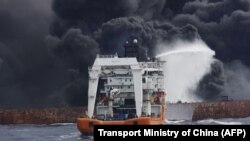Beijing, May 17, 2018 (AFP) - A multinational committee probing a collision between an Iranian oil tanker and a freighter off China has come to differing conclusions over the causes of the accident that led to one of the worst oil spills in decades, according to an investigation report seen by AFP.
The Panama-registered Sanchi, carrying 111,000 tonnes of light crude oil, collided with the Hong Kong-registered CF Crystal in waters off Shanghai on January 6.
The tanker, operated by Iran's NITC, went down in a ball of flames on January 14, and its entire crew of 30 Iranians and two Bangladeshis are presumed dead. The CF Crystal was damaged but was towed to a nearby port and all 21 crew onboard were rescued.
The investigation report, produced by maritime authorities from China, Hong Kong, Iran and Panama, has reached diverging conclusions. Chinese investigators found the Sanchi failed to make way after it saw the other vessel approaching, whereas Iranian and Panamanian investigators blamed a course change by CF Crystal for the accident.
Hong Kong maintained that both vessels were to blame. The investigation based on audio and written recordings from both ships and interviews with surviving crew members from CF Crystal also found that errors by both crews led to the collision. It said each crew neglected to use on-board equipment to gauge the size of the opposing vessel, and failed to take timely action.
The Sanchi had already had a near-miss earlier the same day when a third officer ignored a radio alert from the captain of a fishing vessel, according to the report. The report did not make any recommendations on possible liabilities or penalties for either party.
According to the International Tanker Owners Pollution Federation, the collision led to the worst tanker spill in 35 years. The type of condensate oil carried by the Sanchi does not form a traditional surface slick when spilt, but is nonetheless highly toxic to marine life and much harder to clean up.





